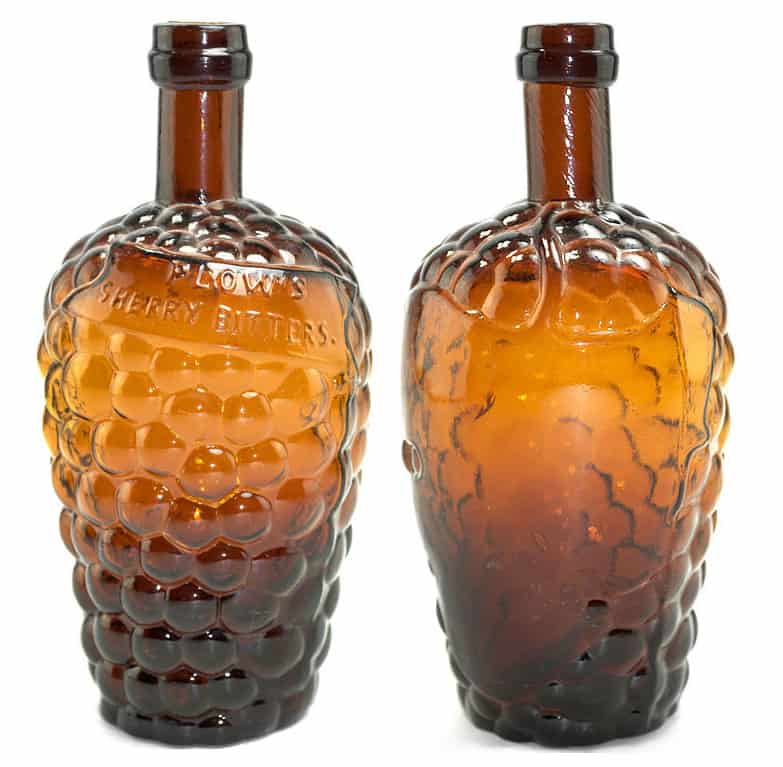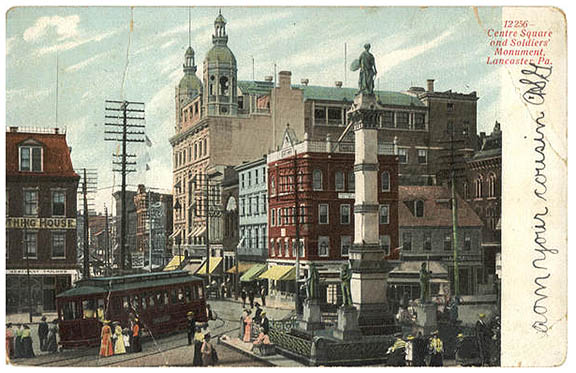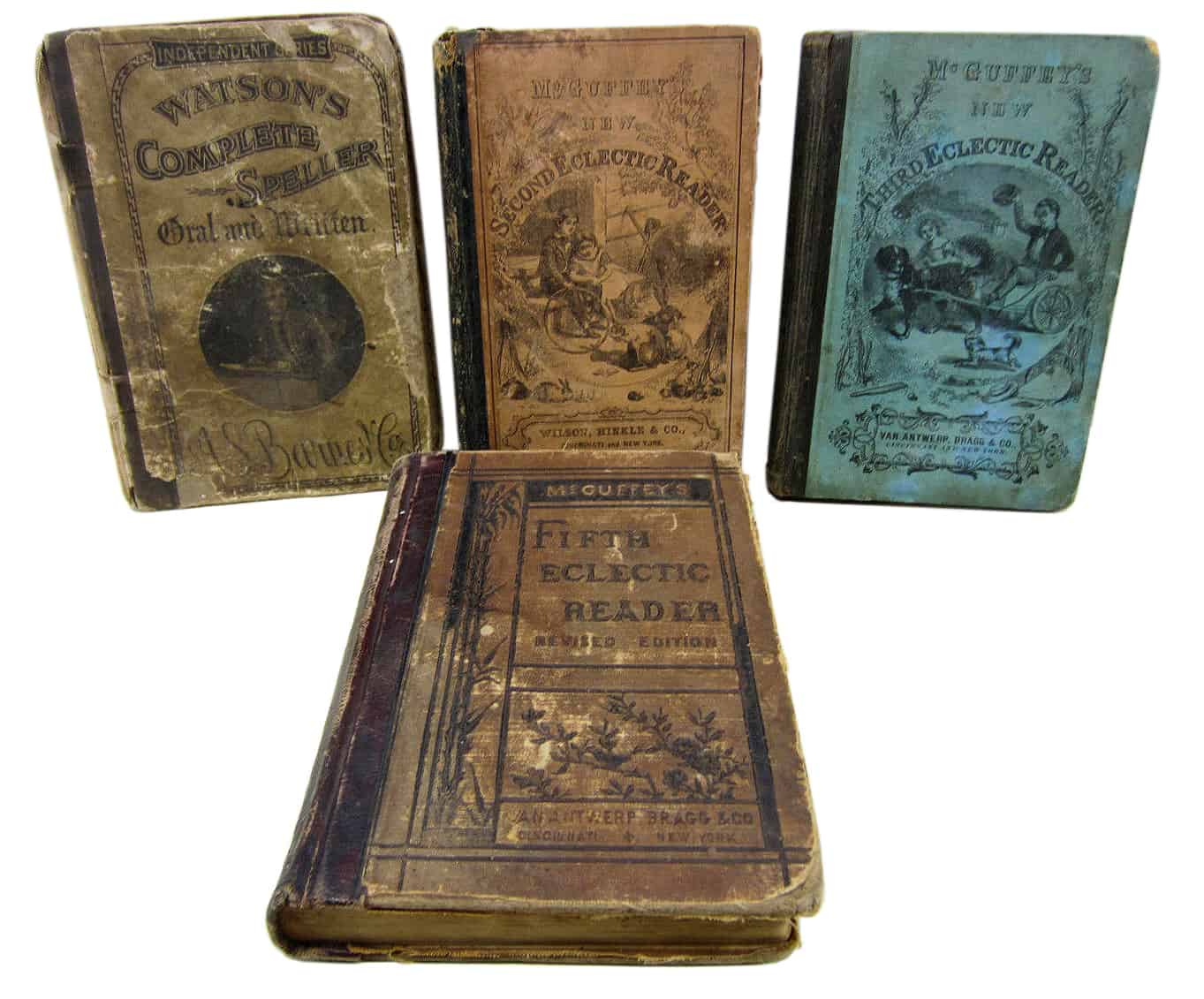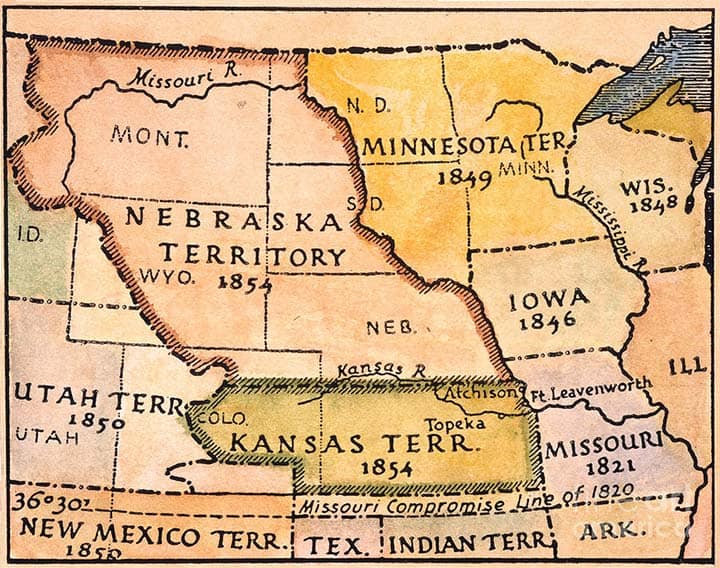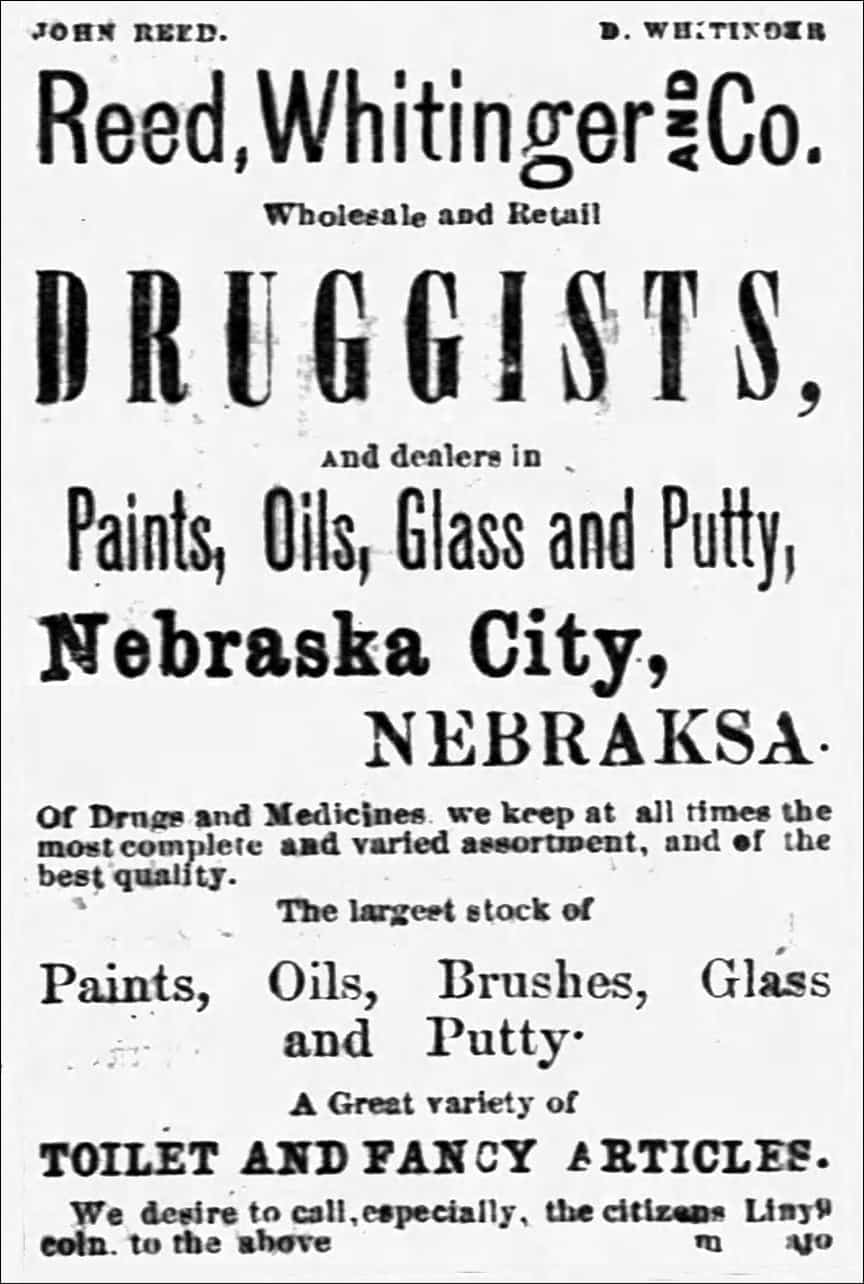
May | 2019
See Daily Dose January – April 2019
31 May 2019 | Friday
Last day of the month. Let’s mop-up with some really rare ephemera that came in for inclusion into Bitters Bottles Supplement 2
Trade card
V 8.5 VAN HORN’S ROOT AND HERB BITTERS, Diecut artists palette on front with image of child eating porridge. Reverse: Presented with the Compliments of T. H. Van Horn, Where you will find the most complete stock of Drugs, Medicines and Groceries Ever Offered in Lockport. Van Horn’s Root and Herb Bitters, Van Horn’s Baking Powder, Van Horn’s 40c Japan Tea. Sugars Cheap.
Theodore H. Van Horn, Chemist and Druggist, Grocers and Provision Dealers, Tea and Spice Dealer, 69 Main – Lockport, New York, City Directory, 1878

Here are a few more examples from Joe Gourd.


30 May 2019 | Thursday
Today we will honor the Atwater Collection at the University of Rochester with four unlisted bitters trade cards. Joe Gourd emailed, “I came across this obituary notice for Edward Atwater. It’s his collection at U. Rochester that we are discussing. He only passed away this past month.”
Trade card
R 106.6 ROUMANIAN HERB AND ROOT STOMACH BITTERS, The Welcome Visitor. Caricature of mailman pulling doorbell on front of card. Reverse: Roumanian Herb and Root Stomach Bitters. As prepared by G. Menole, M.D. are Purely Vegetable and conceded to be the only Non-Alcoholic and Thoroughly Medicated Bitters now found on the market. Roumanian Medicine Co., 774 W. Adams St., Chicago, Ill. Roumanian is a variant spelling of Romanian

Trade Cards
Y 3 DR. WARREN’S YERBA BUENA BITTERS, Portrait on front of Dwight L. Moody, The American Evangelist (card 1) and Carlotta Patti (operatic soprano) (card 2). Compliments of H. Williams & Co. Proprietors of the Yerba Buena Bitters, 65 Montgomery Street. Reverse: Dr. Warren’s Yerba Buena Bitters, The Great Liver Invigorator and Blood Purifier. H. Williams & Co., Homer Williams, W. T. Leavitt, S. T. Foster, Proprietors, 65 New Montgomery Street, San Francisco. Crane & Brigham, Agents.


Trade card
F 61.5 FLORIDA ORANGE STOMACH BITTERS, Florida Orange Wine. Trade Mark. Florida Wine Co., Cincinnati, Ohio. Reverse: Prolong Your Life! We respectfully call your attention to our celebrated “Florida Orange Stomach Bitters.” Price $1.00 per bottle, or six bottles for $5.00. Not Intoxicating. Florida Wine Co. 342 Elm St. Cincinnati, O.

Trade card
A 14.5 AFRICAN BITTERS, Try the Celebrated African Bitters Extra Size Bottles, Finest Tonic in the World. Prices Reasonable. Text surprinted on cloth hung across the fence. The reverse side is blank.

29 May 2019 | Wednesday
Busy day yesterday trying to complete various unlisted bitters material. This first W. M. Crittenton piece is from Joe Gourd. We also updated the listing for Dr. Crittenden’s Dyspepsia and Cocktail Bitters – Philadelphia. Similar but different last names.
Price Sheet
C 251.3 W. M. CRITTENTON & CO., Wholesale and Retail Dealers in Patent Medicines, Bitters, Syrups, Cordials, &C. No. 55 Prince Street, East of Broadway, Late of 476 Broadway. Prices Current, Wild Cherry Bitters, Tonic Bitters, Stoughton Bitters, Stomach Bitters, Aromatic Bitters. A Liberal Discount to the trade.

Trade Cards
C 251.5 DR. CRITTENDEN’S DYSPEPSIA AND COCKTAIL BITTERS, (duotone ship illustrations) E. H. Crittenden (Erastus Henry Crittenden), Manufacturer of…, 258 North Ninth Street, Philadelphia. Reverse: Dealer in Fine Old Whiskies, Brandy, Wines, Champagnes, English and Scotch Ales, &c.

28 May 2019 | Tuesday (BD)
More new listings and updates for Bitters Bottles Supplement 2. These pieces today are from the Joe Gourd collection.
C 195.3 DR. S. COLLIN’S INDIAN HERB BITTERS, Indian Medicine Store, Various medicines listed including on reverse, Indian Herb Bitters, Restores the health to the requirements of nature. Office & Manufactory, No. 150 North 8th Street, Reading, Penn’a

Newspaper Advertisement and Patent
C 237.5 COSSACK A LIQUEUR STOMACH BITTERS (also Cossack Brand Stomachic Bitters and Cossack Stomach Bitters) D. VanDeWart & Son, 2116 Eighth Avenue, New York City. – The Evening Sun (Baltimore, Maryland) December 14, 1914
Patent 106,815 Liqueur Stomach-Bitters, D. VanDeWart & Son, New York, N.Y. – Official Gazette of the United States Patent Office, 1915, See s2V 6.7
Matchbook
V 6.7 VAN DE WART BITTERS, Every Kind of Stomach Bitters For Every Kind of Stomach, Van De Wart Boonekamp Bitters, Cossack Brand Stomachic Bitters, Van De Wart Mint Bitters, Van De Wart Kimmel Bitters, Van De Wart Blackberry Bitters, Van De Wart Coffee Bitters, Vandeco Aromatic Bitters, Try a Drink! of any Van de Wart Bitters. See s2C 237.5

27 May 2019 | Monday (Memorial Day)
Really neat advertising trade card from Joe Gourd for Dr. Callender’s Left Liver Bitters. Crazy name! The bottle is from a past Glass Works Auction. Written up as: “DR CALLENDER’S – LIVER BITTERS”, (Ring/Ham, C-30), Illinois, ca. 1885 – 1895, clear glass with dark olive yellow neck striations, 8 7/8”h, fluted shoulder and side of base panels, smooth base, tooled lip. Pristine perfect condition, a rare bitters bottle!

Newspaper Advertisements
C 29 DR. CALLENDER’S CELEBRATED LIVER BITTERS
1875: Callender’s Celebrated Liver Bitters, Prepared for the trade by Dr. Wm. A. Callender & Sons, Peoria, Ill. – Quad City Times, April 16, 1875
1878: Dr. Callender’s Celebrated Liver Bitters and Blood Purifier, Patented April 4, 1874. Prepared by the inventor and patentee at his factory at South Adams street, Peoria, Illinois. – Hamilton County Democrat, June 14, 1878
1889: Dr. Callender’s Left Liver Bitters, Patent 149,573, Manufactured and for sale at wholesale by Barbero & Callender, Peoria, Ill. – Lincoln Evening Call, Sunday, March 24, 1889
Trade Card
C 30.1 DR. CALLENDER’S LEFT LIVER BITTERS, Front: His first ap-pear-ance (man illustrated as pear) Compliments of the Left Liver Bitters Co., 103 Main St., Peoria, Ill. Reverse: 12-point puzzle. Work the puzzle and you are entitled to a Bottle of the Bitters for One Dollar. Dr. Callender’s Celebrated Left Liver Bitters is manufactured by G. Yaeger & Co. 103 Main St., Peoria, Ill. It is the best bitters manufactured.

A tough card to figure out from the Joe Gourd collection. So very little information on the card. You can get away with that nowadays with a web site address or QR code.
Trade card
C 235.05 COROLLA BITTERS, John Fitzmorris, Proprietor, Reverse blank
Probably John Fitzmorris, Grocer in the 1880s and later restauranteur in Washington D.C. in the 1890s and 1900s.

26 May 2019 | Sunday
This receipt or billhead from Joe Gourd for Constitution Bitters is interesting as Edward J. Liebetrut crossed out Seward and added his name in 1877. This prompted updates in the Bitters Bottles Supplement 2 draft.
C 223 CONSTITUTION BITTERS A.M.S.2. ( au ) / 1864 // CONSTITUTION / BITTERS // A.M.S.2. ( au ) / 1864 // SEWARD & BENTLEY / BUFFALO, N.Y. //
9 1/4 x 2 7/8 x 2 1/4 (7 1/4) 1/4
Rectangular, Amber, LTC, Applied mouth, 4 sp, Rare, Yellow-green and Peach puce, Extremely rare
A.M.S.2. means All Must Surrender To Constitution Bitters
Label: A.M. 1864 S.2. Prepared from a formula of an eminent physician and used for many tears with wonderful success as a tonic, for strengthening of the system, giving tone to the stomach and creating a healthy appetite. It has no equal.
1864 & 1866 Thomas’ Buffalo Business Directory: Seward & Bentley Druggist, 189 Main, Stephen B. Seward and Burr S. Bentley
1868 City Directory for Buffalo: Seward, Bentley & Cheney Druggist, 241 Main 1877 Billhead: Edward J. Liebetrut, Druggist (formerly Seward & Liebetrut, formerly Seward & Co.)
1877 Billhead: Edward J. Liebetrut, Druggist (formerly Seward & Liebetrut, formerly Seward & Co.)
Billhead
223 CONSTITUTION BITTERS, Bought of Edward J. Liebetrut (Seward crossed out and Edward J. written in), (Successors to Seward & Liebetrut, Successors to Seward & Co.) Drugs, Medicines and Perfumery, No. 344 Main Street, Cor. Huron marked out in red and 381 Main Street printed above. Buffalo, N. Y., July 2, 1877. See s2 C 223

Here is a Cool’s Tonic Bitters reference that I have not seen before from Joe’s collection.
Letterhead
C 228.5 COOL’S TONIC BITTERS, Office of the City Drug Store, Drugs, Medicines, Wines and Liquors, Wholesale and Retail, J. H. Cool (James Harris Cool), Proprietor, Oneida, N.Y., Oct. 9, 1890, I Manufacture and Guarantee Cool’s Tonic Bitters (plus six other Cool’s products).

Letterhead
D 21.5 DARLING’S COMPOUND CIDER BITTERS, Anchor Trade Mark Brand. Office of Darling & Company, Manufacturers of Darling’s Compound Cider Bitters, Cor, Abbott and Second Sts. Detroit, Dec 15 1873

25 May 2019 | Saturday
Keeping up with new listings in Bitters Bottles Supplement 2. The next two bitters references are related and originated in 1801.
Invoice
D 17.5 DANIELLS’ BITTERS, Dedham, Mass., April 4, 1849, Receipt of Davenport’s and Wheaton’s Medicines, Davenport’s Pills, Davenport’s Eye Water, Wheaton’s Ointment, Daniells’ Bitters signed Geo. Dixon. See W 82 BBs2.

Newspaper Advertisements
W 82 WHEATONS’ JAUNDICE BITTERS, Patented January 17, 1801, Becomes Daniells’ Bitters in 1832, See D 17.5 in BBs2
Hartford Courant, 1801: Wheaton’s Jaundice Bitters, a new patent medicine
Weekly Wanderer (Randolph, Vermont), 1802: Dr. Wheaton’s Genuine Jaundice Bitters, direct from the Patentee, also Aromatic Bitters
Hartford Courant, 1804: Wheaton’s Jaundice Bitters
The Evening Post (New York City), 1818: Wheaton’s Jaundice Bitters
Buffalo Emporium and General Advertiser, 1826: Wheaton’s Jaundice Bitters
Middlebury Free Press, 1832: Wheaton’s Well Known Jaundice Bitters, The public are informed that by a recent arrangement made with J. Wheaton the genuine bitters will hereafter be offered with J. D. stamped on the lid, and directions signed by J. Daniell instead of J. Wheaton as formerly .

24 May 2019 | Friday
More ephemera from the great collectors being added Bitters Bottles Supplement 2. The Chill-Chilli Bitters trade cards are from Joe Gourd.
C 144.5 L … Chill-Chilli Bitters
9 ¼ x 2 1/2
Square, Amber, LTC, Tooled lip
At least 50% of label is missing obscuring possible portrait of Anita, part of product name, proprietor and location.
Trade Cards
C 145 CHILL-CHILLI BITTERS, Duotone portrait Anita (reverse blank) We All Use Chill-Chilli Bitters, Which is the secret of our success. Manufacturer & Sole Proprietor, Samuel A. Groff, 248 N. Queen St. Lancaster, Pa.
Four-color trade cards (reverse blank) Fancily illustrated beach and ship scenes in horizontal format reading No Chills & Fever Here, Is The Bitters All! CHILL CHILLI Office, No. 248 N Queen St. Lancaster, Pa.
Newspaper Advertisement
C 145 MEDICINE CHILL-CHILLI! – $500 REWARD, Chill-Chill Bitters is an old medicine; was used for hundreds of years by South Sea Islanders for all Diseases; was introduced into England, Portugal, Spain and Germany with the most wonderful curative results; was brought to America by the old Groff family. Manufactured only by Samuel A. Groff, Office and Laboratory, No. 248 North Queen steet; Wareroom, 240 Market street, Lancaster, Pa.
Lancaster Daily Intelligencer, September 29, 1880

The initial Chapman’s trade card from Joe Gourd was a challenge as it was light on information. With a little research, we see that we are talking about Dr. Chapman’s Taraxacum Tonic Wine Bitters and R. W. Robinson & Son in New York City. Joe also provided the 1893 Almanac.
C 129 CHAPMAN’S TARAXACUM TONIC WINE BITTERS
BAR p30, TMS 81, WAT Lost
Farmer’s Almanac 1879, Chapman’s Taraxacum Wine Bitters large and small.
Taraxacum is dried dandelion.
Trade Card
C 129.1 CHAPMAN’S TONIC WINE BITTERS, Are Very Pleasant to the Taste. Illustration, gallantly dressed lad whispering to a young lady on front of card. See C 129.1 Advertisement.
Trade Cards
C 129.1 Dr. CHAPMAN’S TARAXICUM TONIC WINE BITTERS, An Invigorating Tonic. Very pleasant to the taste. In large bottles at 50 cents each. Illustration, gallantly dressed lad giving a flower to a young lady on front of cards. Taraxicum spelled incorrectly. See C 129.1 Advertisement.
Advertisement
C 129.1 DR. CHAPMAN’S TARAXACUM TONIC WINE BITTERS. Liver Connector. In Large Bottles at 50 Cents. 1890, Typography similar to C 129.1 Trade Card. R. W. Robinson & Son, Wholesale Druggists, 182, 184 & 186 Greenwich Street, New York. See C 129.
Farmer’s Almanac 1893, Published by R. W. Robinson & Son, Druggists, 182, 184 & 186 Greenwich Street, New York. Back cover: Dr. Chapman’s Taraxacum Wine Bitters, Liver Corrector, Large Bottles, 50 Cts., Trial Bottles, 10 Cts.



Receipt
L 122.45 PROF. P. LOUD’S TONIC LIVER BITTERS, Bought of Hunt, Rankin & Lamar (L. W. Hunt, J. W. Rankin, H. J. Lamar), Wholesale Druggists, 82 & 84 Cherry Street. Macon, Ga., 1872, Sole Manufacturers and Proprietors of Central City Condition Powders, Central City Worm Candy, Prof. P. Loud’s Cough Syrup, Tonic Liver Bitters …

23 May 2019 | Thursday
Continuing work with Joe Gourd and Bill Ham to include his wonderful unlisted bitters ephemera in Bitters Bottles Supplement 2 (BBS2). Working now in the “C” section. Here are a few from yesterday.
Trade Card
C 63.5 CARPENTER’S HOP BITTERS, Not a Little Fancy Drink but a Thorough-Going Medicine, Large Bottles (half-pints) only 25 Cents, F. M. Carpenter, Prop’r., Waterloo, P.Q. (Province of Quebec) Frank M. Carpenter was a druggist in Quebec. Copyright 1879 printed on front of card.

Advertisement
C 81.5 CASTOREUM BITTERS, A Wonderful Blood Purifier, and Particularly Efficacious in all Lung and Dyspepsia Complaints. Prepared and Sold by A. E. Barron, No. 115 Essex St., Salem, Mass. Adeline E. Barron was a Magnetic Healer and ran a Variety Shop in 1875 when this advertisement appeared. She later specialized primarily in medicines.

C 101.5 L . . . Celebrated Vegetable Stomach Bitters, Worzugliches Magen Bitters, Prepared by Wade Boykin & Co., Baltimore.
9 3/4″
Square, Amber, LTCR, Applied mouth
Advertising Envelope
C 101.5 CELEBRATED VEGETABLE STOMACH BITTERS, Wade, Boykin & Co. envelope header inked out to read Boykin, Carmer & Co. Wholesale Druggist, No. 3 N. Liberty St., Baltimore, Proprietors of Bogg’s German Tonic Bitters, Celebrated Vegetable Stomach Bitters and other products. January 1875 inked on cover. Boykin Carmer & Co. (Dr. Thomas Jackson Boykin and James W. Carmer) also put out the embossed Granger Bitters (G 91).

Cinderella Stamp
B 111.3 BITTER CAMPARI MILANO, David Campari & Co., Milano, Woman holding labeled bottle of Campari Bitters. In Novara, Italy in 1860, Gaspare Campari’s experiments culminated with the invention and secret recipe of a beverage with a distinctive bitter flavor that is available even today. Other cinderella examples exist.

Poster
B 111.3 BITTER CAMPARI, Jester holding labeled bottle of Campari Bitters inside peeled orange skin. Leonetto Cappiello was an Italian and French poster art designer and painter, who mainly lived and worked in Paris. He is now often called ‘the father of modern advertising’ because of his innovation in poster design. Other Campari Bitter posters and advertisements exist using famous designers and artists.

22 May 2019 | Wednesday

Recently obtained Thellers Stomach Bitters image from a anonymous West Coast collector.
“I found an incredibly crude square today. The Thellers Stomach Bitters has a monster applied top and looks 1860s to me. It’s a darker amber. Any thoughts as to rarity? It was dug, so it’s kind of stained up, but is a really nice square. Thanks!”
I’ve only seen a picture of an example before from an old-time northeast collection. This brand was a Hostetter imitator and was in court for their similar methods of labeling and advertising. I possess the labeled Theller’s lady’s leg.

21 May 2019 | Tuesday
More interesting inclusions for Bitters Bottles Supplement 2. Most of the Proctor examples are from the Joe Gourd collection.
O 98.8 L … Superior Oxford Club Orange Bitters, Artificially Colored, (signed) Baird – Daniels Co. Distillers, (embossed) BAIRD – DANIELS COMPANY, GIN DISTILLERS, CONTENTS 1/5 GALLON
Round, 12, Neck seal and stopper, Pale aqua, LTCR
Distillery at Warehouse Point, Conn., Office in New York City

Letterhead
R 10.7 RANNEY’S GOLDEN GATE BITTERS, Established 1861, The H. S. Lincoln Co., Sole Proprietors of Ranney’s Golden Gate Bitters, H. S. Lincoln, L. W. Munroe, Newton Highlands, Mass., Dec 23, 1897

Trade cards
P 145.7 PROCTOR’S VEGETABLE RESTORATIVE BITTERS Long, single-sided cards. Sailing painting and cottage painting. Series No. 37, An Efficient Tonic, Proctor’s Vegetable Restorative Bitters. See s2V 21.1
Postal Card
V 12.1 THE VEGETABLE RESTORATIVE BITTERS cure Jaundice, Headache, Loss of Appetite, Drowsiness, Weakness of the Stomach, Indigestion and all kindred complaints. Prepared and Sold by Benj. Proctor, Apothecary, No. 6 Healey’s Arcade, Lynn (Mass.) 1c postal card (Scott UX5) mailed from Lynn, Mass., On Jun. 7 (1880) See s2P 145.7
Trade card
V 12.1 VEGETABLE RESTORATIVE BITTERS, Four color illustration old-time druggist working in his lab with owl, mortar and pestle and glass bottles. Those who need an invigorating Tonic should use the Vegetable Restorative Bitters. Prepared by Benj. Proctor, Druggist. 6 Healey’s Arcade, Lynn. See s2P 145.7


20 May 2019 | Monday
Working with bitters ephemera specialist Joe Gourd to ensure his unlisted material is included in Bitters Bottles Supplement 2 (BBS2). Still in his vast “B” section. Basically, I check to see if the piece has been previously included in Bitters Bottles or the Supplement, or if Bill Ham has already included it in the BBS2 draft which I am working with. I then arrange the art and send the proposed new listing to Biil to review. He will then give it a number, place it in his latest draft and index. Here are a few from yesterday.
Trade Card
B 235.5 BROWN’S TONIC BITTERS, S.A. Brown, 387 Shawmut Avenue, Boston

Trade Card
B 234.5 BROWN’S SARSAPARILLA BITTERS, The greatest known Appetizer and Blood Purifier. Price 75 cts. per bottle. Prepared by G. W. Brown, Apothecary, Warren, Me.

Trade card
B 214.3 BRIGHT’S SURE KIDNEY AND LIVER BITTERS, A Sure Cure for Bright’s Disease, Reading Hop Bitters Co., Reading, Michigan, See B 214.3 and R 14.5 BBs2.

Print Advertisement
B 216.5 BROOKS TONIC AND LAXATIVE BITTERS, (Ivory Brooks M.D. portrait) Every bottle has the portrait and signature of Ivory Brooks, M.D. on the label. None genuine without. Manufactured by The Brooks Medicine Co., Springville, Me.

Here are a few other new listings from Joe’s collection:
Trade Cards
B 79.5 BERGER’S STOMACH BITTERS, Front illustration of girl with school books and girl descending steps with pets. Reverse stamped Henry Berger’s Cough Balsam, Henry Berger’s Magic Balm, Henry Berger’s Stomach Bitters and Henry Berger’s Blueing.
B 146.7 L … DR. BONKER’S PEPSIN MAGEN=BITTERS, (copy in German) Dr. Bonker Medicine Co., Chicago, Ill. No bottle known. See B 146.5, B 146.7 and B147 in Bitters Bottles and B 146.5 and B 146.7 Bitters Bottles Supplement.
B 163.9 L . . . BOTANIC BITTER COMPOUND. Prepared and Sold Wholesale and Retail, by Dr. S. N. Gould, West Randolph, Vermont, Price 50 cents per box. One box will make 3 qts of Bitters. Can be prepared in whisky, cider, domestic wine, brandy or alcohol.
Trade Card
B 243.5 DR. BUCHAN’S ENGLISH TONIC BITTERS, You should get a Bottle of Dr. Buchan’s English Tonic Stomach Bitters, Locke Chemical Co., Sole Proprietors, Boston, – Mass. Front: Woman in Pilgrim hat promoting Dr. Buchan’s Comp. Sepia Powder.
Advertisement Tag
B 267.5 BURGUNDY WINE BITTERS, Try Burgundy Wine Bitters The Great Invigorator & Tonic
19 May 2019 | Sunday
Here is an updated BBs2 listing for Celery and Chamomile Bitters that took a little detective work. I had trouble reading the bottom part of the label which had a “D. NAS” and “SOUTH AB…” I posted PRG Facebook and Keith Bellew and Brandon DeWolfe pointed me to Charles D. Nash in Abington, Massachusetts. From there, it was easy to research and confirm.
C 107 L … Celery And Chamomile Bitters
Chas. D. Nash Apothecary, Washington St., South Abington, Mass.
A True Tonic and Invigorator for Dyspepsia, Indigestion, Headache, Ague, Colic …
10 x 2 ¾
Square, Amber, LTCR, 3 sp
WAT L32


New Caroni Bitters letterhead listing in Bitters Bottles Supplement 2.
Letterhead
C 57 CARONI BITTERS, Best Tonic and Appetizer (labeled bottle illustration). The Only Genuine Invaluable for Cocktails. Oct. C. Blache & Co., Importers, Offices: 78 & 80 Broad Street, New York, April 22nd, 1913

18 May 2019 | Saturday
Updated Golden Fruit Bitters listing in Bitters Bottles Supplement 2. Example from the Ben Swanson collection.
Puzzle Trade Card
G 63.7 GOLDEN FRUIT BITTERS, The Golden Fruit Bitters cures Indigestion, General Debility, Loss of Appetite… The Golden Fruit Bitters at the nearest Drug Store for 75 cts. Fruit Bitters Company, Baltimore and New York, Wholesale Agents: H. Haswell & Co., Wholesale Druggists, Montreal, Eight concentric circles and optical illusion.
Newspaper advertisement: Ottawa Daily Citizen, Monday, February 18, 1884

Excellent example of a CALIFORNIA FIG BITTERS – CALIFORNIA EXTRACT OF FIG CO. SAN FRANCISCO, CAL. (with original front and back labels, contents), R/H C 15.

17 May 2019 | Friday
Really neat brochure cover from Ben Swanson with new listing in BBS2. I found the newspaper clipping for support information.
Brochure
G 64.1 GOLDEN SEAL BITTERS, Facts For the Million, Dr. Peter W. Schmidt, Called Dr. Pete. His Enormous Practice! His Great Medicines! Golden Seal Bitters and Lung Food for Consumption. The Peoples Hope when Sick. 12-page brochure.
Newspaper advertisement: Golden Seal Bitters, Golden Seal Bitters Co., Holland City, Michigan, Sold by all druggists – The Americus Ledger, Friday, April 24, 1885


15 May 2019 | Wednesday
Posting from Baltimore. This next fine piece is from the Ben Swanson collection. This broadside advertisement contains two unlisted Morton’s bitters and is headed for Bitters Bottles Supplement 2.
Small Broadside
M 139.3 MORTON’S CELEBRATED STOUGHTON, WINE & STOMACH BITTERS, Which are too well known to require comment, as to the excellence of the article. Manufactured by Walter D. Morton, No. 36 West Madison street. Chicago, Ill. Morton’s Golden Aromatic Bitters is also represented.
Small Broadside
M 139.5 MORTON’S GOLDEN AROMATIC BITTERS, Manufactured by Walter D. Morton, No. 36 West Madison street. Chicago, Ill. Morton’s Celebrated Stoughton Wine & Stomach Bitters is also represented.
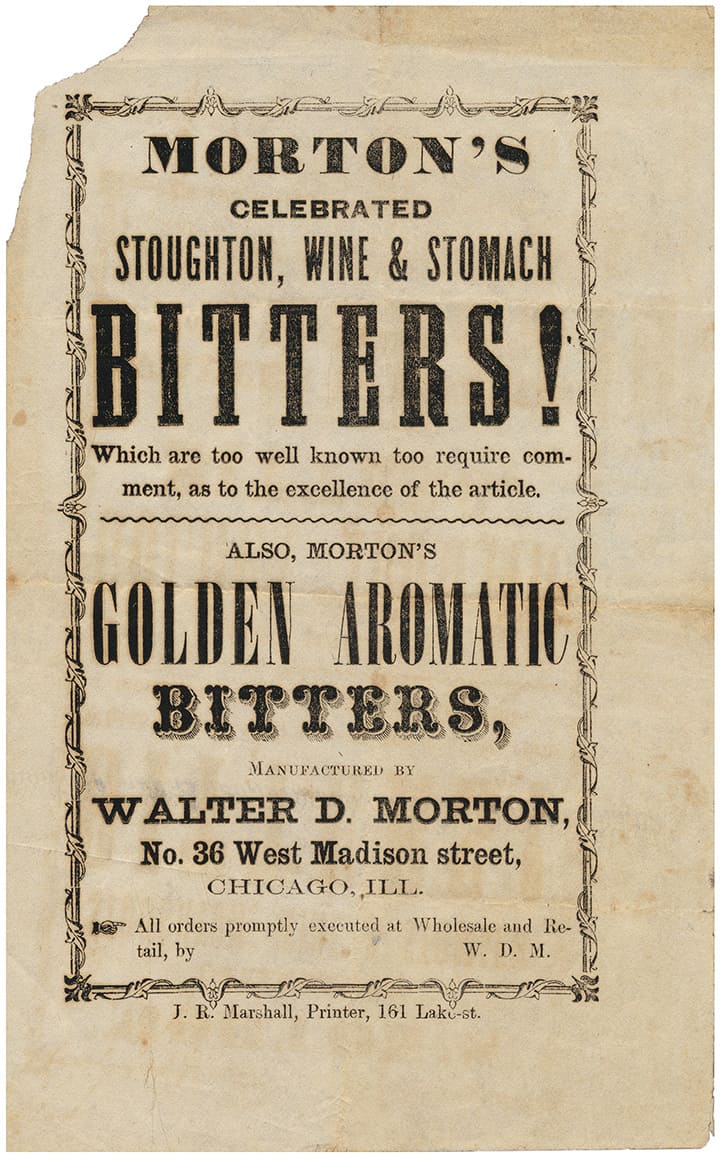
14 May 2019 | Tuesday
Here is a label from Joe Gourd for Buffalo Stomach Bitters that I have not seen before. The new listing in BBS2:
B 250.5 L . . . BUFFALO STOMACH BITTERS, Registered Buffalo Strengthening (Buffalo illustration) Invigorating Stomach Bitters, Steinhardt Bros. & Co., New York, Sole Proprietors Steinhart Brothers & Co., Importers and Wholesale Liquor Dealers, Nos. 299 and 301 Patchen Avenue, Corner Chauncey Street, Brooklyn, N.Y.; 121 and 123 Hudson Street, Corner North Moore. Company founded in 1872 by Lewis Steinhart, the firm becoming Steinhart Brothers in 1878 and in 1887 the firm became Steinhardt Brothers & Co., the individual members being Lewis Steinhart, M. Steinhart, H. Steinhart, D.G. Steinhart and A. Strasser

While researching the Buffalo Bitters above, I came across these other unrelated and unlisted Buffalo Bitters.
Newspaper Advertisement
B 249.6 BUFFALO STOMACH BITTERS, The Buffalo Drug Store, A. Rasure & Co., Proprietors, Myton Block, fourth door west of the land office, Garden City, Kansas
The Daily Sentinel (Garden City, Kansas), Friday, March 19, 1886

Newspaper Advertisement
B 249.7 BUFFALO BITTERS, Geo. H. Smith & Co. Wholesale Dealers in Wines, Liquors, Tobacco, Cigars, Choice Kentucky Bourbon Whiskies, Proprietors Buffalo Bitters, 121 Fourth St., opp Market House, Kansas City
Fort Scott Daily Monitor (Fort Scott, Kansas), Tuesday, May 10, 1870

13 May 2019 | Monday
Interesting folding risqué trade card from the Joe Gourd collection. Now noted in Bitters Bottles Supplement 2.
Trade Card
B 273.7. DR. BURT’S PHILIPPINO LIVER AND KIDNEY BITTERS, Try A Little – Dr. Burt’s Wild Cherry Pepsin, Dam-i-ana Invigorator, Philippino Liver and Kidney Bitters. Adolph Tonic Co., New Philadelphia, Ohio. Risqué novelty folding card



Another card I haven not seen before from the Ben Swanson collection.
Trade Card
P 121.3 PONTIAC ROOT AND HERB BITTERS, The Great System Purifier for Stomach, Liver, Kidney and Blood. Good For Trade Card. Indian rowing canoe illustration. Contains not over 5% Alcohol. Prepared Only By Pontiac Root & Herb Co., 28 North Broad Street, Atlanta, Georgia. A Large One Dollar Bottle of Pontiac Root & Herb Bitters for This Card and 65c. Take to Coursey & Munn’s Drug Store, 29 Marietta Street and get full quart bottle, sufficient for a good Spring course.

12 May 2019 | Sunday
We had a little trouble identifying this next piece from the Ben Swanson collection. This Hercules Tonic Bitters advertisement is headed for Bitters Bottles Supplement 2. The following newspaper advertisement filled in the missing pieces.
Paper Advertisement
H 99.5 HERCULES TONIC BITTERS, Hercules Tonic Bitters! For Dyspepsia, Indigestion, and Disorders of the Stomach and Blood. Hercules Cordial! (Illustration Hercules with Golden Apple of the Hesperides and club, Copyright Secured) Reverse blank. Over stamped in red, Crowell & Miller, Successors to (illegible), Druggists, 155 Main Street, Norwich, Conn.

Newspaper Advertisement
H 99.5 SOMETHING NEW! HERCULES REMEDIES, TONIC DE HERCULES. HERCULES CORDIAL (Illustration Hercules with Golden Apple of the Hesperides and club, Copyright Secured) Hercules Manufacturing Co. 21 Chapel St., Providence, R.I.
Hartford Courant, Thursday, June 24, 1880

I like the juxtaposition of the tranquil sky-blue glass and the rusted metal closure on this Globe fruit jar. When you add the swirls, you have this outstanding piece submitted by Pat Mahon.

11 May 2019 | Saturday

10 May 2019 | Friday
More material for Bitters Bottles Supplement 2.
Advertising Envelope
B 111.3 BITTER ELIXIR OF IRON (Billboard Envelope) One of the Best Tonics Know (sic) is the Bitter Elixir of Iron Prepared by Stewart & Reay, Cor. Hanover & Camden Streets.
Stewart & Reay (James V’D. Stewart and Dr. Henry S. Reay) Apothecaries, southwest corner of Hanover and Camden streets, The Baltimore Sun, March 12, 1867

09 May 2019 | Thursday
A nice Redington & Hostetter & Co. postal cover from the Ben Swanson collection showing Hostetter’s branch office in San Francisco in the 1860s. The Redington drug house was one of the largest on the Pacific Coast. Read more on Hostetter.

08 May 2019 | Wednesday
More material from the advanced collection of bitters ephemera from Joe Gourd. All new listings in Bitters Bottles Supplement 2.
Trade Card
A 143.2 AYER’S AGUE CURE, (Log cabin, swamp alligator and frogs illustration) Ayer’s Ague Cure is a purely Vegetable Bitter Warranted to Cure Fever and Ague and all Malarial Disorders. Prepared by Dr. J. C. Ayer & Co., Lowell, Mass.

Letterhead
L 48.5 LAUBER’S GERMAN KRAUTER BITTERS, Carl F. Lauber, Importer and Dealer in Wines, Liquors, Etc., Established 1880, No. 24 North 9th St., Philadelphia., May 12, 1910. Krauter means Herbs in German. Letterhead also references that Lauber is the Manufacturer of Aromatic Cocktail Bitters and Orange Bitters.
Aromatic Cocktail Bitters, See Carl F. Lauber Letterhead, s2L 48.5
Orange Bitters, See , Carl F. Lauber Letterhead, s2L 48.5
Label
A 86.5 L . . . AROMATIC BITTERS, An Exquisite Tonic Appetiser (sic) Either Plain or Mixed with Wines, Spirits or Minerals. Manufactured & Bottled By Desnoes & Geddes Ltd., 29-35 Orange St, Kingston, Jamaica

07 May 2019 | Tuesday
New American Stomach Bitters reference in Bitters Bottles Supplement 2.
Newspaper Advertisement
A 53.5 AMERICAN STOMACH BITTERS, King of all Bitters, Prepared by American Stomach Bitters Co., General Office, Buffalo, N.Y. This bitters is protected by Trade-Mark and signature of the Originator, Emil DeHeyers (illegible signature), Illustration of round, applied seal, labeled bottle.
Possibly related to A 54, American Stomach Bitters, Rochester, N.Y.
Buffalo Courier, Sunday, March 2, 1902

Trade Card
A 53.7 AMERICAN STOMACH BITTERS, Gerbrauche American Stomach Bitters, Koenig Der Medizinen., German to English Translation: Use American Stomach Bitters, King of Medicines.
Possibly related to A 54, American Stomach Bitters, Rochester, N.Y.
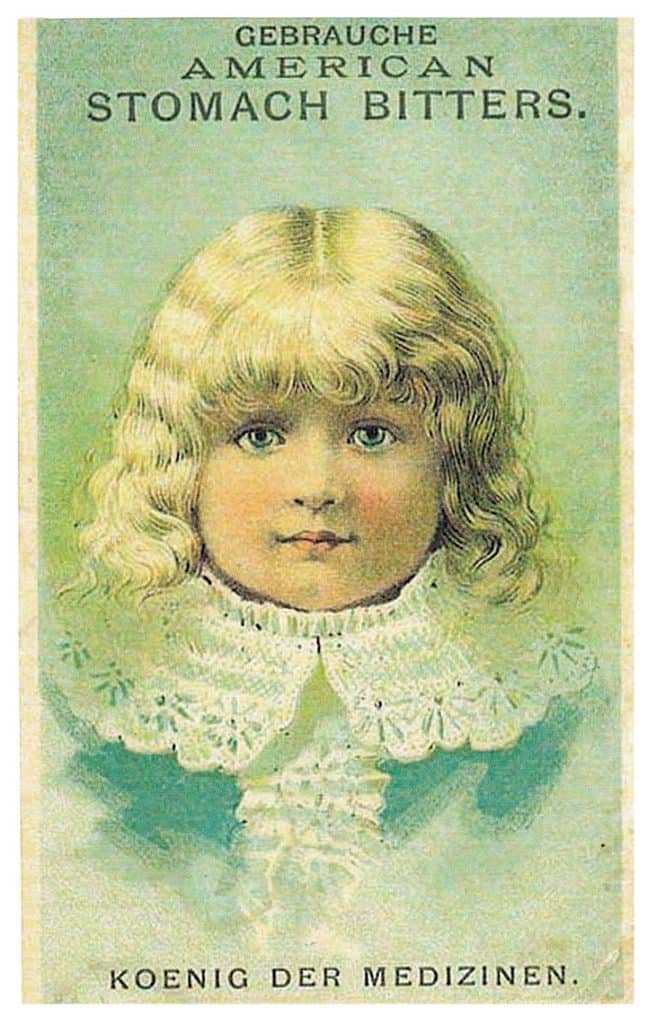
Aunt Charity’s Bitters reference in Bitters Bottles Supplement 2. The advertisement is from the bitters ephemera collection of Joe Gourd.
Almanac Advertisement
A 137 AUNT CHARITY’S BITTERS, Prepared by Hough & Shelton, Proprietors, Corner Main & Beaver Sts., Bridgeport, Ct., Price 50 Cents, 1865. See A 137 in Bitters Bottles.

Unlisted Alburger’s German Bitters reference in Bitters Bottles Supplement 2. The advertisement is from the bitters ephemera collection of Joe Gourd.
Print Advertisement
A 24.5 ALBURGER’S GERMAN BITTERS, A. ALBURGER, M.D., Proprietor of Alburger’s German Bitters, Depot: S.E. Cor. Third and Thompson, Sts., Philadelphia, PA.
1/4 page horizontal advertisement in Philadelphia City Directory, 1876

06 May 2019 | Monday
New Excelsior Stomach Bitters reference in Bitters Bottles Supplement 2. These trade cards are from the collection of Joe Gourd.
Trade cards
E 65.8 EXCELSIOR STOMACH BITTERS, Butter-Cup and Dew Drop (Black Americana). Use Excelsior Stomach Bitters, They Beat the World for a Tonic. Prepared by Devine & Coughlin, Augusta, Maine. Copyright 1882 by M.C. Penniman. Reverse blank. Second series in color featuring children. Reverse blank.
Devine & Coughlin (James E. Devine and John Coughlin) druggists, Water, west of Kennebec bridge, Augusta, Maine, Augusta City Directory, 1888


Pierce’s Peptonized Stomach Bitters reference in Bitters Bottles Supplement 2. The piece is from the collection of Ben Swanson.
Leaflet
P 96.5 PIERCE’S PEPTONIZED STOMACH BITTERS, An Elegant Preparation for Dyspepsia, Indigestion…, Prepared by Heller Chemical Co., Chicago, Ill.
4-panel leaflet on paper. Each panel measures 3.4 x 6 inches.
The Heller Chemical Co. advertised themselves as the Largest and Cheapest Wholesale and Retail Drug House in the World. In 1900, they produced an advertising book with 144 large pages with 1,500 illustrations that gave cut-rate prices on more than 5,000 articles. The Farmers Advocate, Friday, February 22, 1901


05 May 2019 | Sunday (Cinco de Mayo)
Post update: Dr. Petzold’s Genuine German Bitters

New Hooper’s Tonic Bitters reference in Bitters Bottles Supplement 2. The trade card is from the collection of Ben Swanson.
Trade or Calling Card
H 170.3 DR. HOOPER’S CALIFORNIA TONIC BITTERS MANUF’G CO., The Best Tonic in the World. Purely Vegetable. Manufactured at Sanborn, N.Y. Presented by … J. H. Schmeck, Sec’y. Orders Promptly Attended To.

New William’s Royal Crown Remedy And Bitters reference in Bitters Bottles Supplement 2. The piece is from the collection of Ben Swanson.
Brochure
W 120.4 WILLIAMS ROYAL CROWN REMEDY AND BITTERS, Price: $1 A Bottle, Six For $5, Manufactured by Isaac William Company, 268 Dundas St., London, Ont. For Sale By All Druggists, 16 page brochure

04 May 2019 | Saturday
New listing in Bitters Bottles Supplement 2 submitted by Frank Wicker.
L 39.5 LASH’S (l > s) BITTERS (s >l) // f // NATURAL / TONIC LAXATIVE // f //
The middle word “LIVER” has been peened out. On opposite side, the last two letters of NATURES (ES) have been peened out and replaced with ”AL” to read NATURAL
9 3/8 x 2 ¾ (7 ¼)
Square, Amber, LTCR, Tooled Lip, Rare

New Magador Bitters listings in Bitters Bottles Supplement 2. The trade card is from the collection of Ben Swanson
Newspaper Advertisement
M 6.3 MAGADOR AROMATIC BITTERS, Absolutely Vegetable, Delicious to Taste. Sold by all druggists and others. Magador Aromatic Bitters Co., 1537 Pacific Ave., (Tacoma, Washington) – The Tacoma Times, Saturday, November 5, 1910

Trade Card
M 6.4 MAGADOR BITTERS, (Risque Dancer) It’s Delicious! Magador Bitters Cures All Stomach, Kidney and Liver Troubles. At Druggists, Bars and Others, Manufactured at Tacoma, Wash.
See R 98 E.J. ROSE’S MAGADOR BITTERS.


Ben Swanson recently picked up this super-cool oversized Bohemia Bitters trade card off eBay. Joe Gourd then provided images of his stock Bohemia Bitters trade cards. The source is a labeled bottle reference B 136 in Bitters Bottles. The new trade card listing is:
Advertising Trade Cards
B 136 BOHEMIA BITTERS, A Palatable Tonic, A Pleasant Laxative, W. J. Van Schuyver & Co. Inc. Portland, Oregon. Sole Distributors. Oversized vertical card with labeled bottle pictured on front. Reverse blank. Bohemia Bitters nature/floral stock trade cards exist with reverse copy reading essentially the same as above.



03 May 2019 | Friday

Ferdinand, saw your post (23 April 19) about Beacon Bitters and thought you might like to see this crate for their primary product.
https://peachridgeglass.com/2019/01/daily-dose-2019/
We find the bottle you pictured from time to time in privies in Galveston…mostly in the areas that used to make up the red light district. Dug one last Sunday as a matter of fact. They may have bottled their bitters in them, but I’ve only ever found the one size and it fits perfectly in the crate for their Gonorrhea remedy.
By the way, dug a light yellow green L&W Hostetter’s (unfortunately with a small crack) and a nice intact Bavarian Bitters in Galveston on Sunday. Will shoot you some photos of them once I get them cleaned up.
Best Regards,
Brandon DeWolfe, P.E.
Working with some outstanding images from the great Ben Swanson collection of medical ephemera. In this case it is for unlisted bitters material. The new listings in Bitters Bottles Supplement 2 are as follows:
Advertisement
T 3.2 TALLMAN’S BITTERS, A Pint Bottle of Tallman’s Bitters, Made from Hops, Dandelion, Burdock, Yellow Dock, Mandrake, Buchu, Prickly Ash, and Wild Cherry. For 35 Cents. A True Tonic. Prepared by Warren D. Tallman, Syracuse, N. Y. Also in German.
Mechanical Trade Card
T 3.2 TALLMAN’S BITTERS, Oversize trade card consisting of two pieces of board. Between the two boards are two pinned wheels. On each wheel are printed ten faces. The faces appear in apertures on the front of the card as the wheels are rotated. Reverse: A Pint Bottle of Tallman’s Bitters Made From Hops, Yellow Dock, Burdock, Wild Cherry, Dandelion, Prickly Ash, Buchu and Mandrake. For 35 Cts. A True Tonic.
Newspaper Advertisement
T 3.2 TALLMAN’S BITTERS, All Pimples Removed From Face by Using Tallman’s Bitters, Only 35 Cents Per Pint Bottle, For Sale by All Grocers. The News (Patterson, New Jersey), Tuesday, March 15, 1892
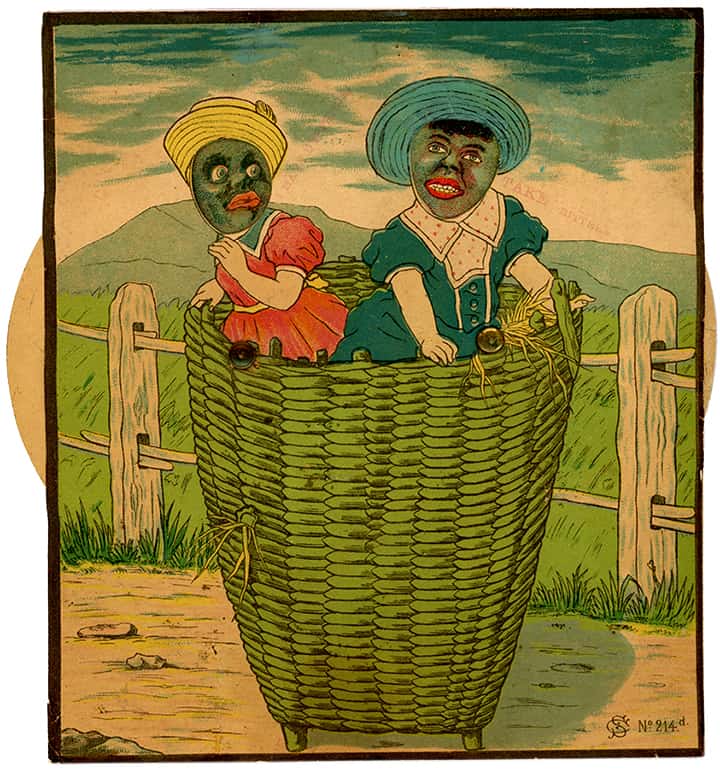




Cover
J 20.7 JANNEY’S OLD DOMINION TONIC BITTERS, Janney & Co., Dealers in Drugs, Paints and Oils, No. 145 King Street, Alexandria, Va. (Samuel H. Janney & Marlon H. Janney)
Newspaper Advertisement: Janney’s Old Dominion Tonic Bitters, In quart bottles, at one dollar each, Janney & Co. – Alexandria Gazette, Saturday, November 14, 1874


Advertising Trade Card
R 14.5 READING HOP BITTERS CO., Ask for Improved Hop Bitters. Put up by Reading Hop Bitters Co., Reading, Michigan (Put up in round bottles. Probably German Hop Bitters, Dr. C.D. Warner, Reading, Michigan. (see G 25 numbers)

02 May 2019 | Thursday

Hi Ferdinand, my name is Gustavo Maisonnave, I’m writing you from Aigua in Uruguay. I am 66, System Engineer, now retired in my farm. www.mpescador.com. Today I was taking stones from a very old “Tapera” (houses constructed using stones in the inner country). Suddenly I found a broken piece of glass with a seal, “Bitter Puyastier” Searching through Internet found your article & e-mail. … regards, Gustavo
Read: Where is the Bitter Puyastier from?
Working with some outstanding images from the great Ben Swanson collection of medical ephemera. In this case it is for unlisted bitters material. The new listings in Bitters Bottles Supplement 2 are as follows:
Advertising Trade Card
D 71.5 DICKINSON’S PERUVIAN IRON BITTERS, (Boy holding tail and running after pig) Dickinson’s Peruvian Bitters gives you Appetite and Refreshing Sleep; surely prevents Chills and Fevers, and almost always cures Dyspepsia.

Advertising Trade Card
G 1 G. A. R. BITTERS, (Mule with advertising blanket) I Don’t Take G.A.R. Bitters, Don’t be a Mule, G.A.R. Bitters Is the Greatest Home Remedy Known, Granger Manufacturing Co., Waukesha, Wisconsin
Newspaper Advertisement: G.A.R. Bitters made by A.L. Granger, a soldier in the 10th Wisconsin to face the disease and heat of the South during the Civil War. $1.00 per Bottle
The Post Crescent, Friday, July 26, 1907


Advertising Trade Card
H 56.3 HARTLEY’S PURE TONIC BITTERS, Try Hartley’s Pure Tonic Bitters for the Malaria and Indigestion. Presented by Hoffman & Gottchalk, Berne & Linn Grove, Indiana Probably related to Hartley’s Peruvian Bark Bitters, Muncie, Indiana (see H54.5, BBs2)

01 May 2019 | Wednesday
Working with some outstanding images from the great Ben Swanson collection of medical ephemera. In this case it is for unlisted bitters material. The new listings in Bitters Bottles Supplement 2 are as follows:
Advertising Envelope
O 60 DR. OLLIN’S GOLDEN BITTERS, Don’t fail to use Dr. Ollin’s Golden Bitters, A. F. Fish, New Bedford, Mass., Proprietor of McDonald’s Iatropon. Anson F. Fish, Wholesale Pedler, 222 County Kempton, New Bedford, Massachusetts
New Bedford, Massachusetts, City Directory, 1867

Advertising Envelope
R 29.7 REGNAULT’S EUREKA BITTERS, Granger & Co., Wholesale Grocers, Titusville, PA., Sole Agents for Regnault’s Eureka Bitters
Newspaper advertisement: Granger & Co., Sole Agents in the United States for Regnault’s Eureka Bitters
The Titusville Herald (Pennsylvania), Saturday, June 12, 1869

Advertising Envelope
B 18.7 BARBER’S FAMILY BITTER’S, Barber Medicine Co., 904 East 19th St. Kansas City, Missouri Barber’s Family Bitters for Medicinal Use. Pleasant to Take, Sure to Cure, Perfectly Safe in Action., Barber Medicine Co., Retail Druggists, James E. Barber, Manager, 900 E. 19th
Kansas City, Missouri Directory, 1896 -1898. Company listed as late as 1941 selling Veterinary Remedies.

![]() As some of you may know, I been working with Bill Ham in getting the Bitters Bottles Supplement 2 book ready for publication. This includes reviewing and cross-referencing material from the great ephemera collections of Joe Gourd and Ben Swanson, among others. In one of the Ben Swanson files were pictures of this great Rheinstrom, Bettman, Johnson & Co. catalogue which contained illustrations of all their products. I included the spread pages below plus clipped bottles that have been enlarged. Very impressive layout and illustrations.
As some of you may know, I been working with Bill Ham in getting the Bitters Bottles Supplement 2 book ready for publication. This includes reviewing and cross-referencing material from the great ephemera collections of Joe Gourd and Ben Swanson, among others. In one of the Ben Swanson files were pictures of this great Rheinstrom, Bettman, Johnson & Co. catalogue which contained illustrations of all their products. I included the spread pages below plus clipped bottles that have been enlarged. Very impressive layout and illustrations.































































































































